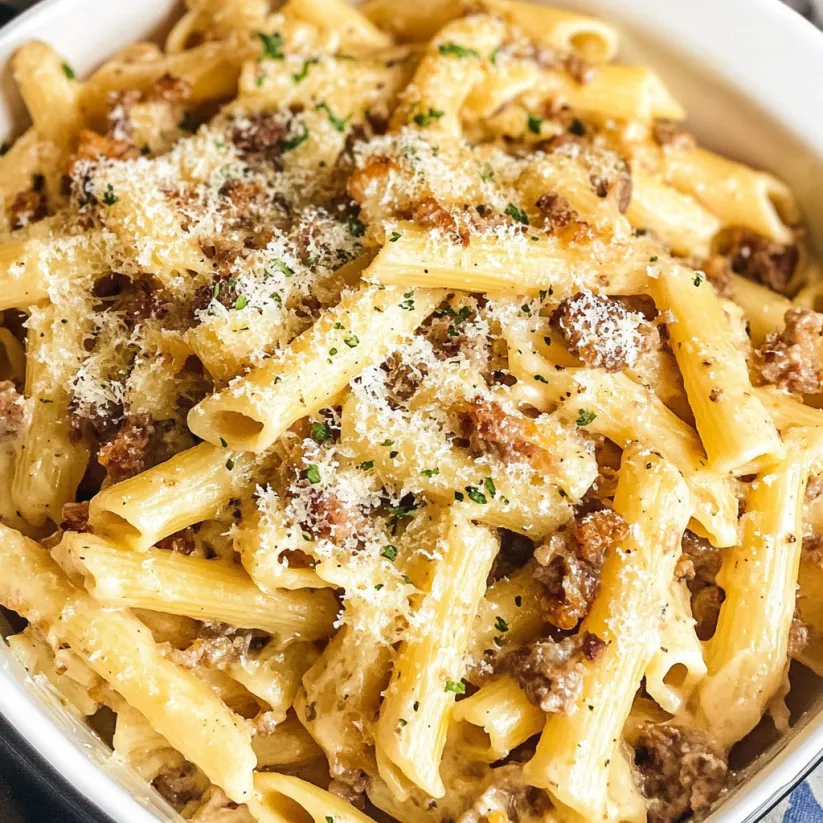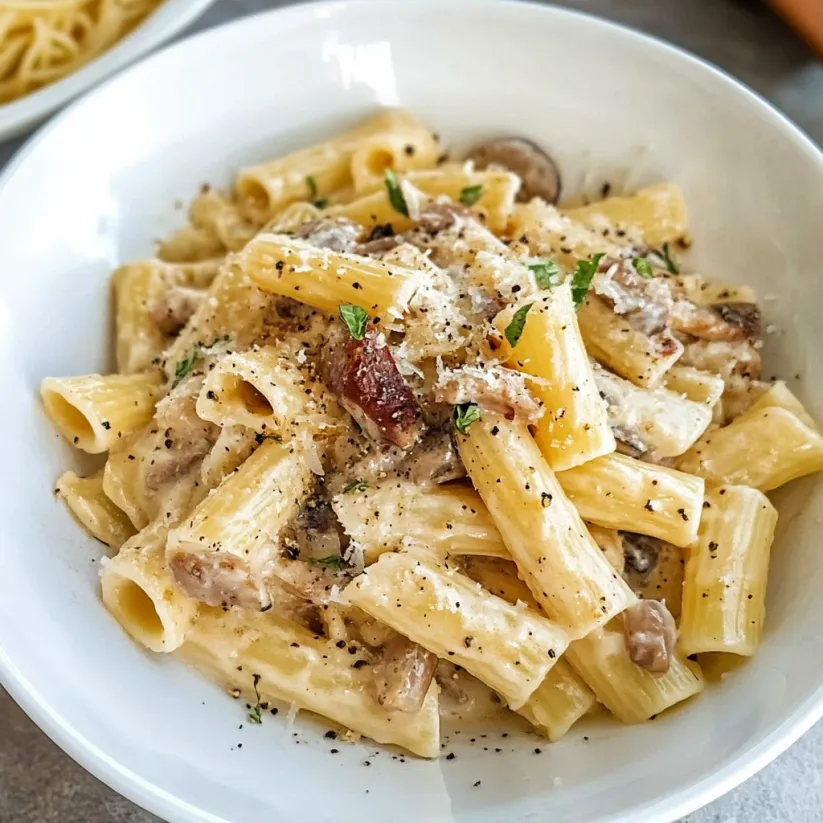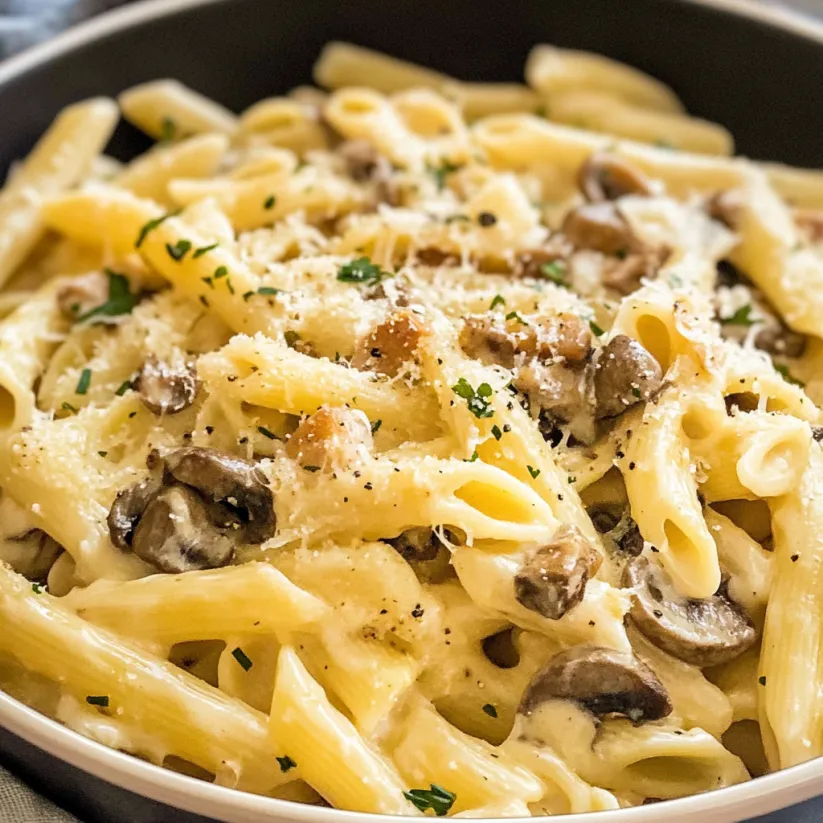 Save Pin
Save Pin
This humble pasta alla gricia has become my Italian cooking cornerstone, showcasing how just four ingredients can create a dish of remarkable depth and satisfaction. The magic happens when guanciale renders its flavorful fat, creating a silky sauce that coats each pasta shape perfectly.
I first discovered pasta alla gricia while traveling through Rome, where a tiny trattoria served this deceptively simple dish that left me speechless. After multiple attempts to recreate it at home, this version finally captures that perfect balance of salt, fat, and pepper that transported me back to that Roman evening.
Ingredients
- Rigatoni pasta absorbs the sauce beautifully with its ridges and tubular shape
- Guanciale provides the richest flavor foundation and necessary fat for the sauce
- Freshly ground black pepper offers essential warmth and spice to balance the richness
- Pecorino Romano cheese brings sharp saltiness and creaminess to complete the dish
Step-by-Step Instructions
- Render the Guanciale
- Cook guanciale pieces over medium heat for a full 10 minutes until golden and crispy. Patience is crucial here as properly rendering the fat creates the foundation of your entire sauce. The fat should be clear and the meat pieces should have a crackly exterior while maintaining some chew.
- Boil the Pasta
- While the guanciale renders, bring heavily salted water to a rolling boil and cook your rigatoni until just al dente. This typically takes one minute less than package directions suggest. The pasta will continue cooking slightly when added to the sauce. Remember to reserve 2 cups of starchy cooking water before draining.
- Start the Sauce
- Toast the freshly ground black pepper in the rendered guanciale fat for about a minute to bloom its flavor. Add 1 cup of the reserved pasta water and bring to a vigorous boil, reducing by half. This concentration of starchy water and fat creates the base for your sauce emulsion.
- Add the Pasta
- Introduce the drained rigatoni to the skillet, tossing thoroughly to coat each piece in the fat and water mixture. Keep moving the pasta continuously to prevent sticking and to help the sauce cling to each piece. Add more reserved water if needed to maintain silkiness.
- Add Half the Cheese
- Incorporate half of the finely grated Pecorino Romano, stirring continuously until it melts completely into the sauce. The heat should be moderate to prevent the cheese from clumping. The sauce should now appear glossy and cling evenly to the pasta.
- Add the Guanciale
- Return the crispy guanciale pieces to the pasta, distributing them evenly throughout. Some pieces will maintain their crispness while others will soften slightly, creating textural contrast in each bite.
- Finish with Cheese and Serve
- Sprinkle the remaining Pecorino Romano over the pasta and add a final crack of fresh black pepper. Serve immediately while the sauce is hot and silky. The pasta should have a glistening appearance with visible flecks of pepper throughout.
 Save Pin
Save Pin
My favorite part of this dish is watching how the humble guanciale transforms completely during cooking. What begins as translucent fatty pork becomes crispy, golden morsels that infuse the entire dish with their distinctive porky depth. My Italian grandmother would always say the quality of your guanciale determines the quality of your gricia.
The Great Guanciale Debate
Finding true guanciale can be challenging outside Italy. While pancetta is often suggested as a substitute, it lacks the distinctive flavor that comes from guanciale's curing process with herbs and spices. The fat content is also different, with guanciale offering a more buttery mouthfeel. If substituting is absolutely necessary, seek out the fattiest pancetta available and consider adding a tiny splash of olive oil to compensate for the different fat content.
Perfecting Your Pasta Water
The pasta water serves as a critical ingredient rather than an afterthought in this recipe. The starch it contains acts as a natural emulsifier that helps bind the fat from the guanciale with the cheese to create a silky sauce. For maximum starch concentration, cook your pasta in less water than you might normally use. The more concentrated the starch, the better your sauce will come together. This technique is fundamental to many traditional Italian pasta dishes.
Regional Variations Worth Noting
While pasta alla gricia is considered a Roman classic, slight variations exist throughout central Italy. In some mountainous regions, black pepper is used more aggressively, while coastal areas might use a slightly different pasta shape. Some families pass down recipes that include a small splash of white wine to deglaze the pan after rendering the guanciale. What remains consistent is the absence of tomatoes, which would transform the dish into amatriciana, gricia's more famous cousin.
 Save Pin
Save Pin
Commonly Asked Questions
- → Can I substitute guanciale with another ingredient?
While traditional Pasta Alla Gricia uses guanciale (cured pork jowl), you can substitute pancetta in a pinch. Bacon is a less authentic option but will work if that's what you have. However, the distinctive flavor of guanciale with its higher fat content does create the most authentic dish.
- → Why is it important to reserve pasta water?
The starchy pasta water is crucial as it helps create the silky sauce texture and binds the ingredients together. The starch acts as a natural thickener, while the salted water adds flavor. Without it, the sauce may separate or become too dry.
- → What pasta shape works best for Pasta Alla Gricia?
Rigatoni is traditional as its ridges and tubular shape capture the sauce beautifully. However, other short pasta shapes like penne or mezze maniche work well too. Long pasta varieties like spaghetti or bucatini are also used in some regional variations.
- → Can I add garlic or onions to Pasta Alla Gricia?
Authentic Pasta Alla Gricia does not contain garlic or onions. Adding these ingredients would transform it into a different dish. The beauty of this recipe lies in its simplicity and the pure flavors of its few ingredients.
- → What's the difference between Pasta Alla Gricia and Carbonara?
While both dishes use guanciale and Pecorino Romano, Carbonara includes eggs which create its signature creamy sauce. Pasta Alla Gricia is often considered Carbonara's predecessor and is sometimes called 'white Amatriciana' since Amatriciana is essentially Gricia with tomatoes added.
- → Why shouldn't I add salt to the sauce?
Both the guanciale and Pecorino Romano are naturally quite salty, and you've already salted the pasta water. Adding more salt would likely make the dish too salty. It's always best to taste first before adding any additional seasoning.
